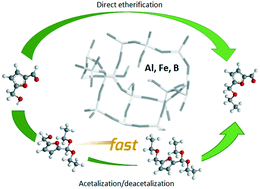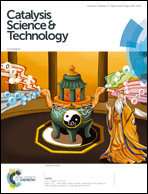Direct versus acetalization routes in the reaction network of catalytic HMF etherification†
Abstract
The etherification of HMF (5-hydroxymethylfurfural) to EMF (5-(ethoxymethyl)furan-2-carbaldehyde) is studied over a series of MFI-type zeolite catalysts containing different heteroatoms (B, Fe, Al), aiming to understand the effect of different isomorph substitutions in the MFI framework on the reaction pathways of HMF conversion. The rate constants in the reaction network are determined for these different catalysts and analyzed with respect to the amount of Brønsted and Lewis acid sites determined by FT-IR pyridine adsorption. Two different pathways of EMF formation, i.e. direct etherification and via acetalization, were evidenced. The Lewis acid sites generated from the presence of aluminum are primarily active in catalyzing direct HMF etherification to EMF, which has a rate constant about one order of magnitude lower than the etherification of the corresponding acetals. This behaviour is due to the competitive chemisorption between hydroxyl and aldehyde groups (both present in HMF) on the Lewis acid sites catalyzing the etherification. A cooperation phenomenon between Brønsted and Lewis acid sites is observed for the HMF acetal etherification to EMF acetal. In the reactions of direct HMF acetalization and deacetalization of the EMF acetal, the turnover frequencies for Silicalite-1 and B-MFI samples are about twice those for Fe-MFI and Al-MFI samples. This is attributed to the different reactivity of strong silanol groups associated with surface defects on the external surface in Silicalite-1 and B-MFI. These sites are also responsible for the EMF-to-EOP (ethyl 4-oxopentanoate) reaction step. In the deacetalization reaction of the EMF acetal, the behavior is determined from the presence of water (product of reaction) favouring the back reaction (aldehyde formation).



 Please wait while we load your content...
Please wait while we load your content...